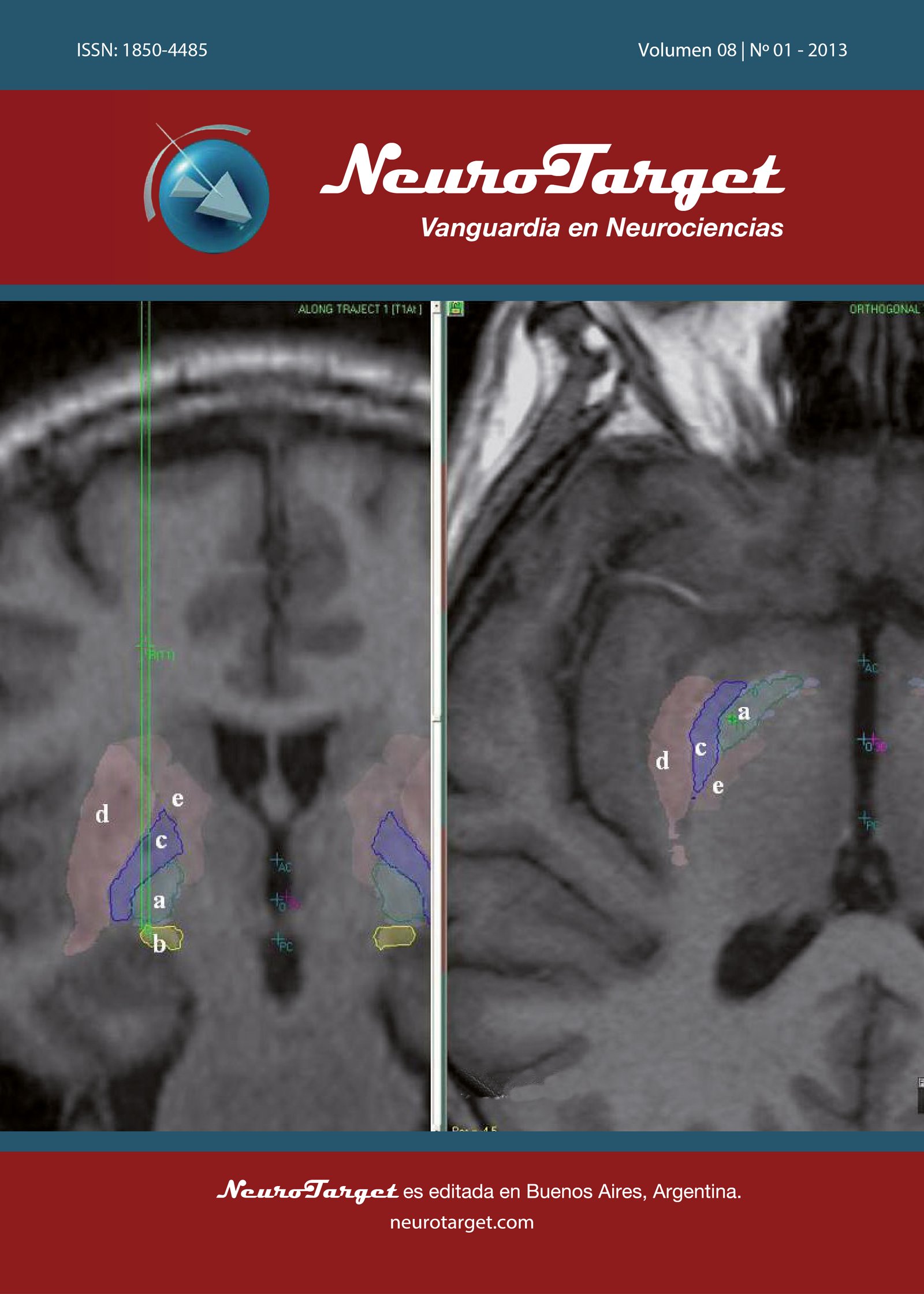Percutaneous fentanyl for postoperative spinal arthrodesis analgesia
Published in Dor Journal. São Paulo, 2011;12(2):115-9
DOI:
https://doi.org/10.47924/neurotarget2013269Keywords:
Analgesia, Arthrodesis, Fentanyl, Percutaneous adhesive, SpineAbstract
Background and Objectives: Moderate to severe postoperative pain control is still a daily problem due to pain in the intervals between analgesic administration and to adverse effects. Percutaneous fentanyl induces continuous analgesia for up to 72 hours and has been used to control acute pain. This study aimed at evaluating percutaneous fentanyl analgesia to control acute postoperative pain in patients submitted to spinal arthrodesis, as well as at observing the incidence of fentanyl-related adverse effects.
Method: Participated in this study 9 patients submitted to spinal arthrodesis under general anesthesia with propofol, sufentanil and cisatracurium and maintenance with remifentanil and isoflurane. One 12 μg/h percutaneous fentanyl adhesive was applied before surgery and ketoprofen, dipirone and tramadol were administered at surgery completion. Dipirone was administered every 6 hours as rescue analgesic drug. Pain intensity was evaluated every 12 hours by the visual analog scale and dipirone and ketoprofen consumption was evaluated every 12-hours; adverse effects were recorded
Results: Twelve hours after adhesive application, mean pain intensity was 2.11 ± 2.84. Highest pain intensity was observed 60 hours after adhesive application and lowest value was observed 24 and 72 hours after percutaneous fentanyl adhesive application. Highest total dipirone consumption was 8000 mg in the period between 60 and 72 hours and between 36 and 48 hours and the lowest consumption was zero mg in the period between 60 and 72 hours, but there has been no statistically significant difference in observed periods (p = 0.47). Side effects were one case of sleepiness and one of nausea and vomiting.
Conclusion: This study suggests that percutaneous fentanyl is safe and effective for postoperative spinal surgery pain. Results have also shown that percutaneous fentanyl has minor side effects.
Metrics
References
Mattia C, Coluzzi F. Acute postoperative pain management: focus on iontophoretic transdermal fentanyl. Ther Clin Risk Manag 2007;3(1):19-27.
Pratice guidelines for acute pain management in the perioparative setting: an updated reported by the American Society of Anesthesiologists Task Force in Acute Pain Management. Anesthesiology 2004;100(6):1573-81.
Smith G, Power I. Audit and bridging the analgesic gap. Anaesthesia 1998;53(6):521-2.
Thompson JP, Bower S, Liddle AM, Rowbotham DJ. Perioperative pharmacokinetics of transdermal fentanyl in elderly and young adult patients. Br J Anaesth 1998;81(2):152-4.
Gourlay GK. Treatment of cancer pain with transdermal fentanyl. Lancet Oncol 2001;2(3):165-72.
Viscusi ER, Reynolds L, Tait S, Melson T, Atkinson LE. An iontophoretic fentanyl patient-activated analgesic delivery system for postoperative pain: a double-blind, placebo-controlled trial. Anesth Analg 2006;102(2):188-94.
Summer GJ, Puntillo KA, Miaskowski C, Green PG, Levine JD. Burn injury pain: the continuing challenge. J Pain 2007;8(7):533-48.
Apfelbaum JL, Chen C, Mehta SS, et al. Postoperative pain experience: results from a national survey suggest postoperative pain continues to be undermanaged. Anesth Analg 2003;97(2):534-40.
Salomaki TE, Hokajarvi TM, Ranta P, Alahuhta S. Improving the quality of postoperative pain relief. Eur J Pain 2000;4(4):367-72.
Dolin SJ, Cashman JN, Bland JM. Effectiveness of acute postoperative pain management: I. Evidence from published data. Br J Anaesth 2002;89(3):409-23.
Sathyan G, Jaskowiak, Evashenk M,Gupta S. Characterisation of the pharmacokinetics of fentanyl HCl patient-controled transdermal system (PCTS): effect of current magnitude and multiple-day dosing, and comparison with IV fentanyl administration. Clin Pharmacokinet 2005;44(Suppl 1):7-15.
Ground S, Hall J, Spacek A, Hoppenbrouwers M, Richarz U, Bonnet F. Iontophoretic transdermal system using fentanyl compared with patient-controlled intravenous analgesia using morphine for postoperative pain management. Br J Anesth 2007;98(6):806-15.
Viscusi ER, Siccardi M, Damaraju CV, Hewitt DJ, Kershaw P. The Safety and efficacy of fentanyl iontophoretic transdermal system compared with morphine intravenous pacient-controlled analgesia for postoperative pain management: an analysis of pooled data from three randomized, active-controlled clinical studies. Anesth Analg 2007;105(5):1428-36.
Chelly JE, Grass J, Houseman TW, Minkowitz H, Pue A. The safety and the efficacy of a fentanyl patient-controlled transdermal system for acute postoperative analgesia: a multicenter, placebo-controlled trial. Anesth Analg 2004;98(2):427-33.
Skinner HB. Multimodal acute pain management. Am J Orthop 2004;33(5 Suppl):5-9.
Closs SJ, Barr B, Briggs M, Cash K, Seers K. A comparison of five pain assessment scales for nursing home residents with varying degrees of cognitive impairment. J Pain Symptom Manage 2004;27(3):196-205.
Minkowitz HS, Rathmell JP, Vallow S. Gargiulo K, Damaraju CV, Hewitt DJ. Efficacy and safety of the fentanyl iontophoretic transdermal system (ITS) and intravenous patient-controlled analgesia (IV PCA) with morphine for pain management following abdominal or pelvic surgery. Pain Med 2007;8(8):657-68.
Pennington P, Caminiti S, Schein JR, Hewitt DJ, Nelson WW. Patients’ assessment of the convenience of fentanyl HCI iontophoretic transdermal system (ITS) versus morphine intravenous patient-controlled analgesia (IV PCA) in the management of postoperative pain after major surgery. Pain Manag Nurs 2009;10(3):124-33.
Panchal SJ, Damaraju CV, Nelson WW, Hewitt DJ, Schein JR. System-related events and analgesic gaps during postoperative pain management with the fentanyl iontophoretic transdermal system and morphine intravenous patient-controlled analgesia. Anesth Analg 2007;105(5):1437-41.
Downloads
Published
How to Cite
Issue
Section
License
Copyright (c) 2013 José Nilson Fortaleza de Araújo, Samantha Ottoni Adolphsson Zidan, Rute Maria Araújo Cavalcante, Roberto Cesar Ponte Ibiapina

This work is licensed under a Creative Commons Attribution 4.0 International License.
The article is distributed under the Creative Commons Attribution 4.0 License. Unless otherwise stated, associated published material is distributed under the same licence.







